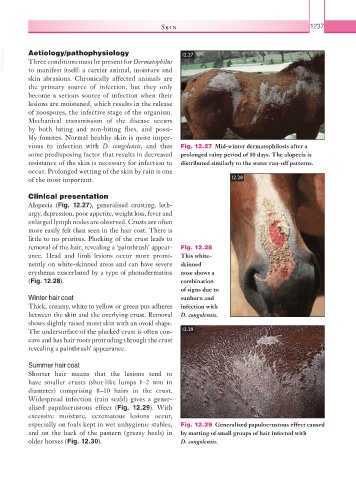Page 1262 - Equine Clinical Medicine, Surgery and Reproduction, 2nd Edition
P. 1262
Skin 1237
VetBooks.ir Aetiology/pathophysiology 12.27
Three conditions must be present for Dermatophilus
to manifest itself: a carrier animal, moisture and
skin abrasions. Chronically affected animals are
the primary source of infection, but they only
become a serious source of infection when their
lesions are moistened, which results in the release
of zoospores, the infective stage of the organism.
Mechanical transmission of the disease occurs
by both biting and non-biting flies, and possi-
bly fomites. Normal healthy skin is quite imper-
vious to infection with D. congolensis, and thus Fig. 12.27 Mid-winter dermatophilosis after a
some predisposing factor that results in decreased prolonged rainy period of 10 days. The alopecia is
resistance of the skin is necessary for infection to distributed similarly to the water run-off patterns.
occur. Prolonged wetting of the skin by rain is one
of the most important. 12.28
Clinical presentation
Alopecia (Fig. 12.27), generalised crusting, leth-
argy, depression, poor appetite, weight loss, fever and
enlarged lymph nodes are observed. Crusts are often
more easily felt than seen in the hair coat. There is
little to no pruritus. Plucking of the crust leads to
removal of the hair, revealing a ‘paintbrush’ appear- Fig. 12.28
ance. Head and limb lesions occur more promi- This white-
nently on white-skinned areas and can have severe skinned
erythema exacerbated by a type of photodermatitis nose shows a
(Fig. 12.28). combination
of signs due to
Winter hair coat sunburn and
Thick, creamy, white to yellow or green pus adheres infection with
between the skin and the overlying crust. Removal D. congolensis.
shows slightly raised moist skin with an ovoid shape.
The undersurface of the plucked crust is often con- 12.29
cave and has hair roots protruding through the crust
revealing a paintbrush’ appearance.
Summer hair coat
Shorter hair means that the lesions tend to
have smaller crusts (shot-like lumps 1–2 mm in
diameter) comprising 8–10 hairs in the crust.
Widespread infection (rain scald) gives a gener-
alised papulocrustous effect (Fig. 12.29). With
excessive moisture, eczematous lesions occur,
especially on foals kept in wet unhygienic stables, Fig. 12.29 Generalised papulocrustous effect caused
and on the back of the pastern (greasy heels) in by matting of small groups of hair infected with
older horses (Fig. 12.30). D. congolensis.

